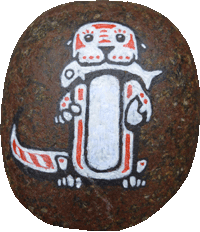24th May 2011
Today we took a boat out to Rangitoto Island, an extremely young volcanic island in Auckland harbour. Less than 300 years ago local Maoris were able to watch Rangitoto erupt steaming from the waters of the bay, but now it is covered with trees and bushes that grow thick among the black lumps of basaltic rock. At some point in the next few hundred years a new volcano is likely to pop up somewhere else in this very active area; it could be out in the bay, it could be under the city centre. Yikes.
The island is good for a few hours exploring. The tramp up to the summit is good exercise and the views of Auckland well worth it. There are lava caves to explore and the vegetation on the island is interesting for being so different from anywhere else. These are early colonising species, even the big trees which are specially adapted with roots that can creep a long way down through the rocks in search of water.
I was surprised to find a notice on the island explaining that Brush-tailed Rock Wallabies had been introduced here by early colonists. How exciting! This is the rare species of rock wallaby that recently died out in the state of Victoria and only has a couple of remaining colonies in New South Wales. At Adelaide Zoo they were running a captive breeding programme to try and increase the population and reintroduce some into the wild. Wallabies don’t get pregnant while they have a joey in the pouch, so the zoo was using another kind of rock wallaby as surrogate mothers for the babies allowing the female Brush-tailed Rock Wallabies to breed more frequently.
Anyway, the notice on Rangitoto went on to say that these wallabies were damaging the rare indigenous vegetation on the island and so in the 1990’s an eradication programme was started and they were wiped out by the year 2000.
So in one country they are captive breeding an animal, and in the neighbouring country they exterminating the same animal as pests. Both in the name of conservation. Crazy.
Related Images:













































